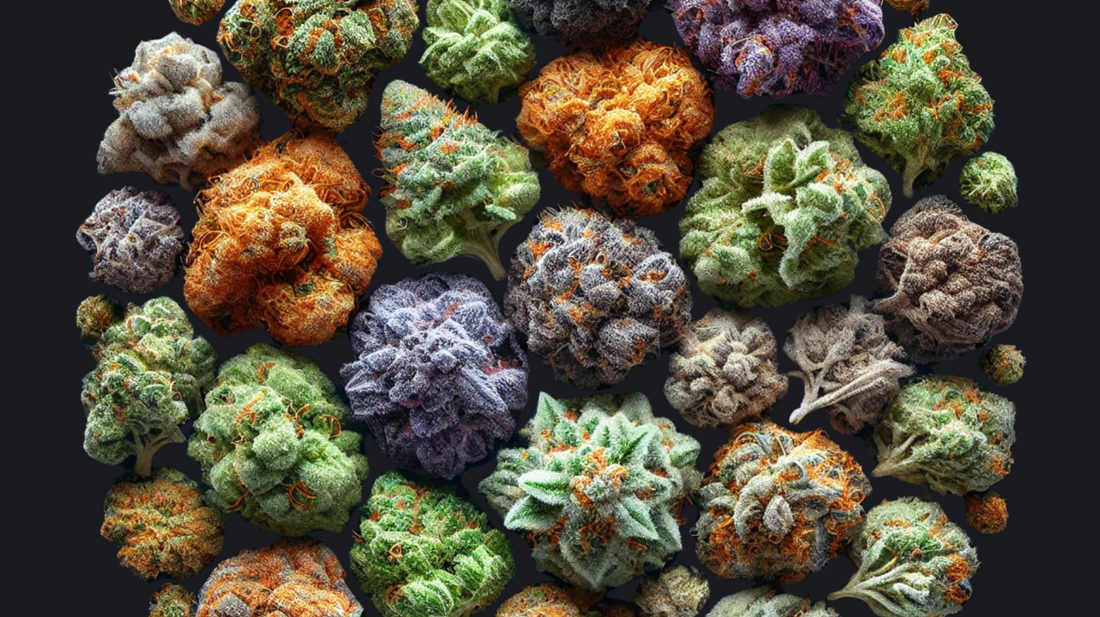
The Meaning Behind Cannabis Colors: A Comprehensive Scientific Guide
Cannabis plants exhibit a remarkable spectrum of colors, ranging from vibrant greens to deep purples, fiery reds, and golden yellows. But beyond their visual appeal, these colors result from intricate biochemical interactions involving genetics, environmental factors, and plant pigments.
Understanding the science behind cannabis coloration can enhance cultivation practices for growers and deepen consumer appreciation of different strains. In this guide, we’ll break down the primary pigments, the factors influencing color expression, and whether color has any impact on potency and flavor.
The Science of Cannabis Pigmentation
Chlorophyll: The Dominant Green Pigment
Chlorophyll is the primary pigment in plants, essential for photosynthesis. It absorbs light energy to drive growth and is responsible for the classic green hue found in most cannabis strains. Younger plants or strains with high chlorophyll retention will appear bright green, while chlorophyll breakdown can reveal other pigments.
Anthocyanins: The Source of Purple, Blue, and Red Hues
Anthocyanins belong to the flavonoid family and contribute to red, purple, and blue shades in cannabis. Their expression depends on several factors:
-
pH Levels:
- Acidic conditions → Red hues
- Neutral pH → Purple hues
- Alkaline conditions → Blue hues
- Temperature: Cooler night temperatures can stimulate anthocyanin production, enhancing purple and blue coloration.
- Strains Rich in Anthocyanins: Granddaddy Purple, Purple Haze, and Blueberry Kush.
Carotenoids: The Warm-Toned Pigments
Carotenoids are responsible for yellow, orange, and red hues in cannabis. These pigments become more visible as chlorophyll degrades, particularly in strains nearing harvest. Strains such as Tangie and Lemon Kush exhibit vibrant yellow and orange tones due to elevated carotenoid levels.
What Influences Cannabis Colors?
1. Genetics – The Blueprint for Color
Genetics determine the plant’s potential for developing different hues. Some strains naturally produce more anthocyanins or carotenoids, making them predisposed to unique colors.
Examples of colorful strains:
- Granddaddy Purple & Purple Haze → High anthocyanin content (purple)
- Lemon Kush & Tangie → High carotenoid content (yellow/orange)
- Pink Kush → Anthocyanins + carotenoids creating pinkish hues
2. Environmental Conditions – Nature’s Palette
While genetics set the baseline, external factors influence the final coloration:
a) Temperature (Cooler Nights = More Color)
- Cooler temperatures during flowering enhance anthocyanin expression, creating purple and blue hues.
- Example: Granddaddy Purple turns a deep violet when exposed to cool nights.
b) Light Exposure (UV & Intensity)
- High UV exposure stimulates anthocyanin production, intensifying reds and purples.
- Indoor growers use LED grow lights to manipulate pigment expression.
c) Soil pH and Nutrient Availability
- Acidic soil (low pH): Promotes red pigmentation.
- Alkaline soil (high pH): Encourages blue hues.
- Phosphorus and magnesium levels can impact pigment production.
Decoding Cannabis Colors – What Do They Mean?
| Color | Cause | Examples |
|---|---|---|
| Green | High chlorophyll content | OG Kush, Sour Diesel |
| Purple/Blue | High anthocyanins, cool temperatures | Granddaddy Purple, Blueberry Kush |
| Red/Pink | Anthocyanins + carotenoids, pH influence | Pink Kush, Red Congolese |
| Yellow/Orange | Carotenoid expression, chlorophyll degradation | Tangie, Lemon Kush |
Does Color Affect Potency and Flavor?
A common misconception is that darker or more vibrant cannabis is stronger or more flavorful. However, scientific evidence shows: Color does NOT determine THC or CBD levels. Pigments do not affect terpene profiles. Anthocyanins and carotenoids have antioxidant properties, but no direct psychoactive effects.
What Really Affects Potency and Flavor?
- Cannabinoid Profile: THC, CBD, and minor cannabinoids like CBG and CBN influence effects.
- Terpene Composition: Aromatic compounds such as myrcene, limonene, and pinene dictate the strain’s smell and taste.
Example: A deep purple Granddaddy Purple isn’t stronger than a green phenotype of the same strain—they have identical cannabinoid content, with color differences due to environment and genetics.
Conclusion – The Art and Science of Cannabis Colors
The diverse color spectrum of cannabis is a complex interplay of genetics, environment, and plant biochemistry. While these hues enhance visual appeal, they do not indicate potency or quality. When selecting cannabis, focus on cannabinoid and terpene profiles, not just color.
Next time you admire a vividly colored strain, appreciate the science behind its beauty!
Sources :
- PubMed : Leaf Pigmentation in Cannabis sativa: Characterization of Anthocyanin Biosynthesis in Colorful Cannabis Varieties.
- Kannabia : How to Increase the Levels of Anthocyanin When Growing Purple Strains
- Cannabis Science and Technology : Enhancing Anthocyanin Levels in Cannabis: Environmental Factors at Play.
